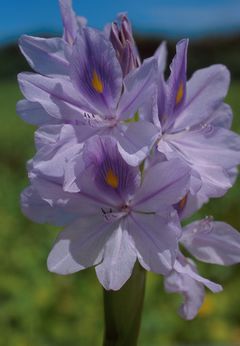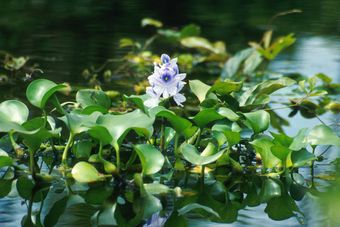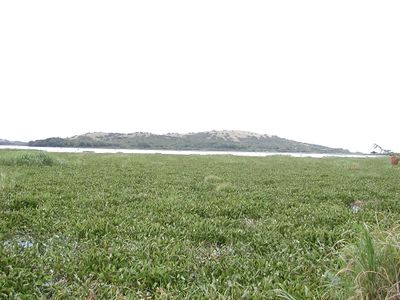ورد النيل
| ورد النيل Water Hyacinth | |
|---|---|

| |
| Common Water Hyacinth (E. crassipes) | |
| التصنيف العلمي | |
| مملكة: | |
| Division: | |
| Class: | |
| Order: | |
| Family: | |
| Genus: | Eichornia |
| Species | |
|
Seven species, including: | |
الأنواع السبعة من ورد النيل water hyacinths تكون جنس Eichhornia. وورد النيل هو نبات مائي حولي طافي موطنه الأصلي أمريكا الجنوبية المدارية. With broad, thick, glossy, ovate leaves, water hyacinths may rise above the surface of the water as much as 1 meter in height. The leaves are 10-20 cm across, and float above the water surface. They have long, spongy and bulbous stalks. The feathery, freely hanging roots are purplish black. An erect stalk supports a single spike of 8-15 conspicuously attractive flowers, mostly lavender to pinkish in colour with six petals. When not in bloom, water hyacinth may be mistaken for frog's-bit (Limnobium spongia).
One of the fastest growing plants known, water hyacinth reproduces primarily by way of runners or stolons, which eventually form daughter plants. It also produces large quantities of seeds, and these are viable up to thirty years. The common water hyacinth (Eichhornia crassipes) is a vigorous grower known to double its population in two weeks.
. . . . . . . . . . . . . . . . . . . . . . . . . . . . . . . . . . . . . . . . . . . . . . . . . . . . . . . . . . . . . . . . . . . . . . . . . . . . . . . . . . . . . . . . . . . . . . . . . . . . . . . . . . . . . . . . . . . . . . . . . . . . . . . . . . . . . . . . . . . . . . . . . . . . . . . . . . . . . . . . . . . . . . . .
Invasiveness as an exotic plant
الاستغلال الصناعي
Since the plant has abundant nitrogen content, it can be used a substrate for biogas production and the sludge obtained from the biogas. However, due to easy accumulation of toxins, the plant is prone to get contaminated when used as feed.
السمـّية
Endogenous
N/A
Exogenous
The plant is extremely tolerant towards, and of high capacity of uptaking heavy metals, such as Cd, Cr, Co, Ni, Pb and Hg etc, which could be utilized for the biocleaning of industrial wastewater [1], [2], [3], [4]. Not only the heavy metals, Eichhornia crassipes can also remove toxins, such as cyanide, a process which is environmentally beneficial in areas that have endured gold mining operations [5].
هامش
- ^ Upadhyay, Alka R. (2007). "Principle and Process of Biofiltration of Cd, Cr, Co, Ni & Pb from Tropical Opencast Coalmine Effluent". Water, Air, & Soil Pollution. Springer. 180 (1–4): 213–223. doi:10.1007/s11270-006-9264-1. Retrieved 11 November.
{{cite journal}}: Check date values in:|accessdate=(help); Unknown parameter|accessyear=ignored (|access-date=suggested) (help); Unknown parameter|coauthors=ignored (|author=suggested) (help) - ^ Abou-Shanab, R. A. I.; et al. (2007). "Chromate-Tolerant Bacteria for Enhanced Metal Uptake by Eichhornia Crassipes (MART.)". International Journal of Phytoremediation. 9 (2): 91–105. doi:10.1080/15226510701232708.
{{cite journal}}:|access-date=requires|url=(help); Check date values in:|accessdate=(help); Cite has empty unknown parameter:|coauthors=(help); Explicit use of et al. in:|first=(help); Unknown parameter|accessyear=ignored (|access-date=suggested) (help) - ^ Maine, M.A.; et al. (2006). "Nutrient and metal removal in a constructed wetland for wastewater treatment from a metallurgic industry". Ecological Engineering. Elsevier. 26 (4): 341–347. doi:10.1016/j.ecoleng.2005.12.004.
{{cite journal}}:|access-date=requires|url=(help); Check date values in:|accessdate=(help); Cite has empty unknown parameter:|coauthors=(help); Explicit use of et al. in:|first=(help); Unknown parameter|accessyear=ignored (|access-date=suggested) (help) - ^ Skinner, Kathleen; et al. (2007). "Mercury uptake and accumulation by four species of aquatic plants". Environmental Pollution. Elsevier. 145 (1): 234–237. doi:10.1016/j.envpol.2006.03.017.
{{cite journal}}:|access-date=requires|url=(help); Check date values in:|accessdate=(help); Cite has empty unknown parameter:|coauthors=(help); Explicit use of et al. in:|first=(help); Unknown parameter|accessyear=ignored (|access-date=suggested) (help) - ^ Ebel, Mathias; et al. (2007). "Cyanide phytoremediation by water hyacinths (Eichhornia crassipes)". Chemosphere. Elsevier. 66 (5): 816–823. doi:10.1016/j.chemosphere.2006.06.041.
{{cite journal}}:|access-date=requires|url=(help); Check date values in:|accessdate=(help); Cite has empty unknown parameter:|coauthors=(help); Explicit use of et al. in:|first=(help); Unknown parameter|accessyear=ignored (|access-date=suggested) (help)
6. Ambrose, Philippa . "Water hyacinth chokes lake Victoria." Marine Pollution Bulletin 34. 6Jun1997 364.
7. Kateregga, Eseza, and Sterner,Thomas. "Indicators for an invasive species: Water hyacinths." Ecological Indicators Volume 7, Issue 2Apr2007 362-370.
8. LVEMP. "LAKE VICTORIA ENVIRONMENTAL MANAGEMENT PROJECT." Lake Victoria Environmental Management Project . 31Aug2004. World Bank.
9. Opande, G.O., Onyang, J.C., Wagai, S.O.. "Lake Victoria: The water hyacinth (Eichhornia crassipes [MART.] SOLMS),its socio-economic effects, control measures and resurgence in the Winam gulf." Limnologica 34. 1-2 May2004 105-109.
10. United Nations News Highlights, "Fighting water weeds in West Africa." Food and Agriculture Organization of the United Nations. 16Aug2000.


